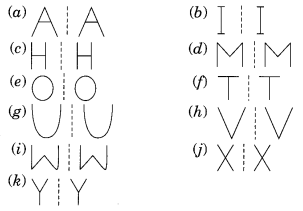Class 6 Maths Chapter 9 Extra Questions Symmetry
Class 6 Maths Symmetry Extra Questions
NCERT Class 6 Maths Chapter 9 Symmetry Extra Questions and Answers
Question 1.
In the following figures, identify the figure that has:
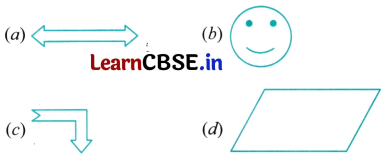
(i) line of symmetry
(ii) rotational symmetry
(iii) both line of symmetry and rotational symmetry
(iv) neither line of symmetry nor rotational symmetry
Solution:
(i) Figures (a) and (b) have line of symmetry.
(ii) Figures (a) and (d) have rotational symmetry.
(iii) Figures (a) has both line of symmetry and rotational symmetry.
(iv) Figures (c) has neither line of symmetry nor rotational symmetry.
Question 2.
How many lines of symmetry do the following English alphabets have?
(i)
![]()
(ii)
![]()
Solution:
The letters H and I of English alphabets have two lines of symmetry, as shown below:
(i)
![]()
(ii)
![]()
![]()
Question 3.
How many lines of symmetry do the following letters of English alphabets have?
(i)
![]()
(ii)
![]()
Solution:
The letters F and J of English alphabets, do not have any line of symmetry.
Question 4.
Write any five letters of English alphabets such that they have one line of symmetry. Show the line of symmetry for each of them.
Solution:
Following letters of English alphabets have only ‘one line of symmetry’ as shown below:
![]()
Question 5.
List all the letters of English alphabets which have rotational symmetry.
Solution:
Following letters of English alphabets have rotational symmetry.

Question 6.
Complete each of the following figures such that the dotted line is the Tine of symmetry’.
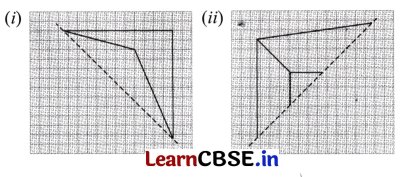
Solution:
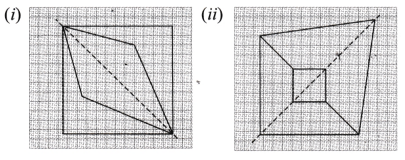
Question 7.
Find the lines of symmetry and rotational symmetry of the following figure.
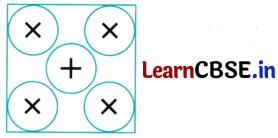
Solution:
There are four lines of symmetry in the figure as shown here.

The rotational symmetry are as follows:

The given figure comes back to its original shape when we rotate it about 90°, 180°, 270° and 360°.
Thus, the given figure has 4 angles of symmetry (90°, 180°, 270° and 360°).
![]()
Question 8.
State whether the figure shows rotational symmetry. If yes, then what is the order of rotational symmetry?

Solution:
The given figure shows rotational symmetry, which is clear from the following figure:

The given figure looks exactly the same when it is rotated about 60°, 120°, 180°, 240°, 300° and 360°. The order of rotational symmetry of the given figure is 6.
Question 9.
What is the smallest angle of symmetry of
(i) an equilateral triangle,
(ii) a square?
Solution:
(i) The smallest angle of rotational symmetry of an equilateral triangle is 120°. ‘

(ii) The smallest angle of rotational symmetry for a square is 90°.

Question 10.
Assertion: The given figure has two lines of symmetry.
Reason: A line that cuts a plane figure into two parts that exactly overlap when folded along that line is called a line of symmetry of the figure.

In the given question, a statement of Assertion is followed by a statement of Reason. Choose the correct option as:
(a) Assertion and Reason both are correct and Reason is the correct explanation of the Assertion.
(b) Assertion and Reason both are correct but Reason is not the correct explanation of the Assertion.
(c) Assertion is correct but Reason is not correct.
(d) Assertion is not correct but Reason is correct.
Solution:
The given figure has no lines of symmetry.
So, the correct option is (d).
Question 11.
A square piece of paper (figure 1) is folded along its diagonals as shown in figure (2) and (3). Then cut off 3 pieces of the form of congruent isosceles right-angled triangles out of it as shown in figure 4.

On opening the piece of paper, which of the following shapes will form?

Solution:
On opening the piece of paper, shape (c) will be formed.
![]()
Question 12.
Minimum, how many unit squares will you colour so that the figure has:
(i) only one line of symmetry?
(ii) two lines of symmetry?
(iii) four lines of symmetry?
(iv) only a horizontal line of symmetry?

Solution:
(i) One unit square will be coloured to have only one line of symmetry.

(ii) Two unit squares will be coloured to have two lines of symmetry.

(iii) Four unit squares will be coloured to have four lines

(iv) Two unit squares will be coloured to have only a horizontal line of symmetry.

Question 13.
Given the line (s) of symmetry, find the other hole (s):

Solution:

Symmetry Class 6 Extra Questions Very Short Answer Type
Question 1.
Write four such English letters which have no line of symmetry.
Solution:
The 4 English letters having no line of symmetry are: P, F, G and Z.
Question 2.
Write 5 such English letters which have horizontal line of symmetry.
Solution:
The required letters are:
E, B, C, D,K
Question 3.
Write 4 English letters which have vertical lines of symmetry.
Solution:
The required English letters are A, H, I, M
Question 4.
How many symmetrical lines do they have?
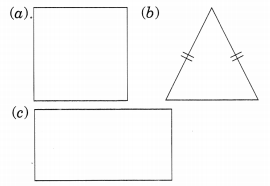
Solution:
(a) The figure is a square. It has 4 lines of symmetry.
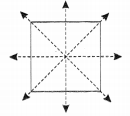
(b) It is an isosceles triangle. It has one vertical line of symmetry.
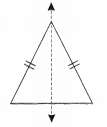
(c) The given figure is a rectangle which has two lines of symmetry.
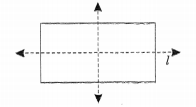
Question 5.
Find in which of the following, the dotted line is a line of symmetry.
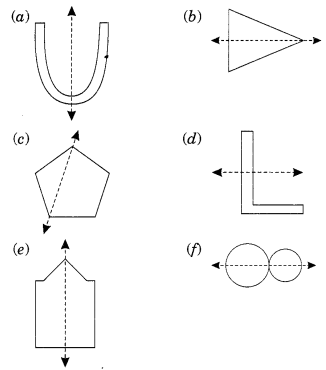
Solution:
(a) The dotted line is a line of symmetry.
(b) The dotted line is a line of symmetry.
(c) The dotted line is not a line of symmetry.
(d) The dotted line is not a line of symmetry.
(e) The dotted line is a line of symmetry.
(f) The dotted line is a line of symmetry.
Symmetry Class 6 Extra Questions Short Answer Type
Question 6.
How many lines of symmetry does (a) a rectangle (b) a square (c) a parallelogram have? What about right angled triangle?
Solution:
(a) Rectangle has two lines of symmetry
(i) Horizontal
(ii) Vertical
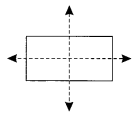
(b) Square has four lines of symmetry.
(i) 1 horizontal
(ii) 1 vertical
(iii) 2 diagonally
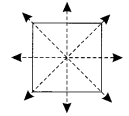
(c) Parallelogram has no lines of symmetry

Right angled triangle has no line of symmetry.

Question 7.
Fill in the blanks:
(a) An angle is symmetrical about its …….. .
(b) A circle has …….. lines of symmetry.
(c) A rectangle …….. has lines of symmetry.
(d) A square has …….. lines of symmetry.
(e) A letter D has …….. lines of symmetry.
(f) A letter N has …….. lines of symmetry.
(g) A kite is symmetrical about its longer …….. .
(h) A scalene triangle has …….. lines of symmetry.
(i) A line of symmetry of an object is also called its …….. of symmetry.
(j) An equilateral triangle has …….. lines of symmetry.
(k) A regular pentagon has …….. lines of symmetry.
(l) A line of …….. divides a figure into two similar parts.
Solution:
(a) bisector
(b) infinite
(c) two
(d) four
(e) one
(f) no
(g) diagonal
(h) no
(i) axis
(j) three
(k) five
(l) symmetry
Question 8.
Show by figure the English alphabets which look the same in their reflected image.
Solution:
The following English alphabets look same after reflections.
